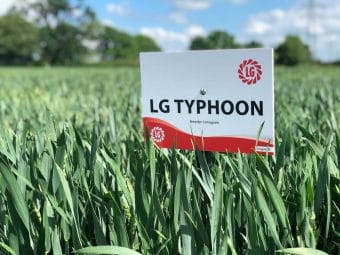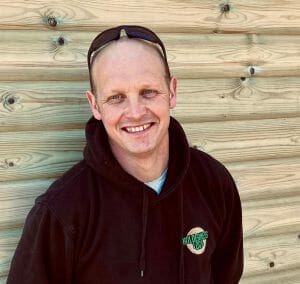
Regenerative practices that are less reliant on artificial inputs require farmers to select varieties with attributes that can help them thrive in such conditions.
It is something East Yorkshire farmer, Jonathan Hodgson of I M Hodgson & son Ltd, recognises, after converting the 280 ha farm, to a reduced input, strip tillage system in 2019.
There is a diverse rotation on the medium to heavy clay farm, east of Hull, featuring winter wheat, oilseed rape, spring barley, spring oats, winter beans, vining peas, flax, and herbal leys. Cover crops are grown ahead of spring crops, while short-term catch crops are also included wherever possible, namely after vining peas, or oilseed rape, ahead of wheat.
“We’re trying to build diversity into the rotation, but our primary focus remains on first wheats; that’s what we’re always trying to get back to as quickly as we can,” says Mr Hodgson.
This season, he is growing a range of varieties, including 20 ha of the hard Group 4, LG Typhoon, alongside LG Astronomer for seed, trial areas of LG Aldaniti and LG Redwald, plus Costello, KWS Extase, Theodore, and a four-way blend trial.
It is the second year of growing LG Typhoon, after a successful 3 ha trial of the variety last year, on land previously in pasture.
Desirable traits for regen
Mr Hodgson’s decision to grow LG Typhoon followed a conversation with Limagrain UK’s arable technical manager, Ron Granger, who says the variety has certain attributes that suit strip tillage/ direct drilling, regenerative crop establishment systems.
Mr Granger says LG Typhoon had been on the farm in a Limagrain UK demo trial, alongside commercial and up-and-coming varieties, for a couple of seasons, and it was clear the variety offered better suitability for the direct drilling, wider row situation.
“It was a stand out variety,” says Mr Granger.
LG Typhoon’s growth habit, for example, means plants sit prostrate with slower growth through the winter into spring, which is ideal for those direct drilling earlier in the autumn and do not want a variety that will race off too quickly.
It is high tillering and has the capacity to utilise the space between the wider rows, often found with some direct drilling equipment. Indeed, Mr Hodgson’s Mzuri drill has a relatively wide row spacing of around 300 mm centres.
LG Typhoon’s strong standing power and disease resistance – reflected by its high untreated yield (92%) – further suits those looking for flexibility with crop protection inputs, Mr Granger says. Unlike some feed varieties, it also offers Orange Wheat Blossom Midge (OWBM) resistance, in addition to a six-rating for eyespot and Fusarium.
“It’s a high yielding, consistent and resilient variety, that delivers across seasons and rotations.”
For Mr Hodgson, the biggest draw is LG Typhoon’s robust disease package, particularly the Septoria rating of 7.3, and yellow rust rating of 9.
“That’s what I look for in a variety, probably more so than outright yield. What can it offer in terms of agronomy, and is it a good, stable, variety that will let me look after a crop how I want to, instead of relying on a can to keep it clean?”
Cutting inputs
Last year’s LG Typhoon lived up to promises, yielding 11 t/ha from limited inputs – about 10% up on the farm’s five-year average yield.
The crop received two fungicides – 0.5 L/ha Amistar (azoxystrobin), and 1 L/ha Verydor XE (fluxapyroxad + Mefentrifluconazole) – and a total of 160 kg N/ha.
“We have been trying for a number of years to reduce fungicide inputs, but last year was the first time we’ve done so on a farm-scale, albeit helped by relatively low disease pressure.”
Indeed, one variety on the farm did not receive any fungicide inputs in 2022, and still yielded over 10 t/ha. Other crops did receive fungicides at different stages of the season, reflecting Mr Hodgson’s desire to remain flexible and adapt to the conditions.
“We want to be flexible. If the plant looks healthy, I won’t put a product on, but if it needs one, we will still use a fungicide. Last year, some crops had a T1, others got a T2, and some first wheats had a T1.5 instead of a T1, as that’s when we decided to go on. We won’t rule out using fungicides, but it’s a measured approach, field-by-field and variety-by-variety.”
While looking to reduce reliance on fungicides, Mr Hodgson is keen to support plant health in other ways, notably through more targeted nutrition, utilising in-depth soil testing, and sap analysis, to determine requirements.
He is also changing the way nitrogen is applied, by moving to a “little and often” approach, rather than applying large amounts in one go, which can cause surges of weak growth fuelled by simple sugars, potentially making plants more prone to lodging, and attack by pests and disease.
This approach typically sees 160 kg N/ha applied in four liquid applications of 40 kg N/ha every 15-20 days, from early to mid-March onwards. A carbon source is included with each nitrogen application to improve uptake efficiency. Programmes are completed with a final foliar nitrogen application. “This only provides about 10 kg N/ha, but the nitrogen use efficiency is far greater than applying nitrogen to the soil,” notes Mr Hodgson.
“Our aim is to keep plants healthy and growing at a consistent, steady rate, instead of causing surges of growth that need to be managed with PGRs.”
Additional fertility comes from the 1,100 tonnes of pig manure produced on the farm each year, applied on a rotational basis.
Supporting establishment
Mr Hodgson acknowledges that in the first years of converting to strip tillage, establishment was lower than with conventional tillage, as soils took time to adjust.
Seed rates were therefore increased to compensate. This season’s 20 ha block of LG Typhoon, was sown at 400 seeds/m2 on 27 September, after oilseed rape, using home-saved seed, with no dressing (just cleaned in a mobile seed plant and tested for fusarium).
“However, we are now seeing an improvement in soils and drilling conditions, so I think we can start to reduce seed rates slightly. It’s been a steep learning curve.”
To support crop establishment and soil health, Mr Hodgson also includes two liquid products – fish hydrolysate and humic acid – in a band with seed at planting. “The hydrolysate is full of amino acids, so the idea is to prime the soil by helping the biology.”
No starter fertilisers are used, and he points out that no phosphate or potash has been applied for the past four to five years. “Most soils have tonnes of P and K; we just need to be better at getting plants to access it.”
Mr Hodgson says this year’s LG Typhoon established very well in a relatively kind autumn and winter, growing on well through spring. Disease-wise, it looks “pretty clean”, despite having not received any fungicide, or growth regulator, up until the time of writing (beginning of May).
“There is more disease pressure this year than last, so we’ll have to remain on the ball and keep checking crops.
“It generally takes two to three years to get to know a variety properly, so it is still early days, but so far, LG Typhoon seems to suit our system.”
LG Typhoon
High yielding, consistent Group 4 feed wheat
Strong disease resistance, particularly Septoria (7.3) and yellow rust (9) – 92% untreated yield
OWBM resistance, good standing ability
Adaptable drilling dates – suits early drilling, also excellent as a second wheat
High tillering capacity and a slower, prostrate growth habit through winter into spring, and the plant’s ability to fill space, suits wider row direct drilling re-gen systems.

LG Typhoon
































